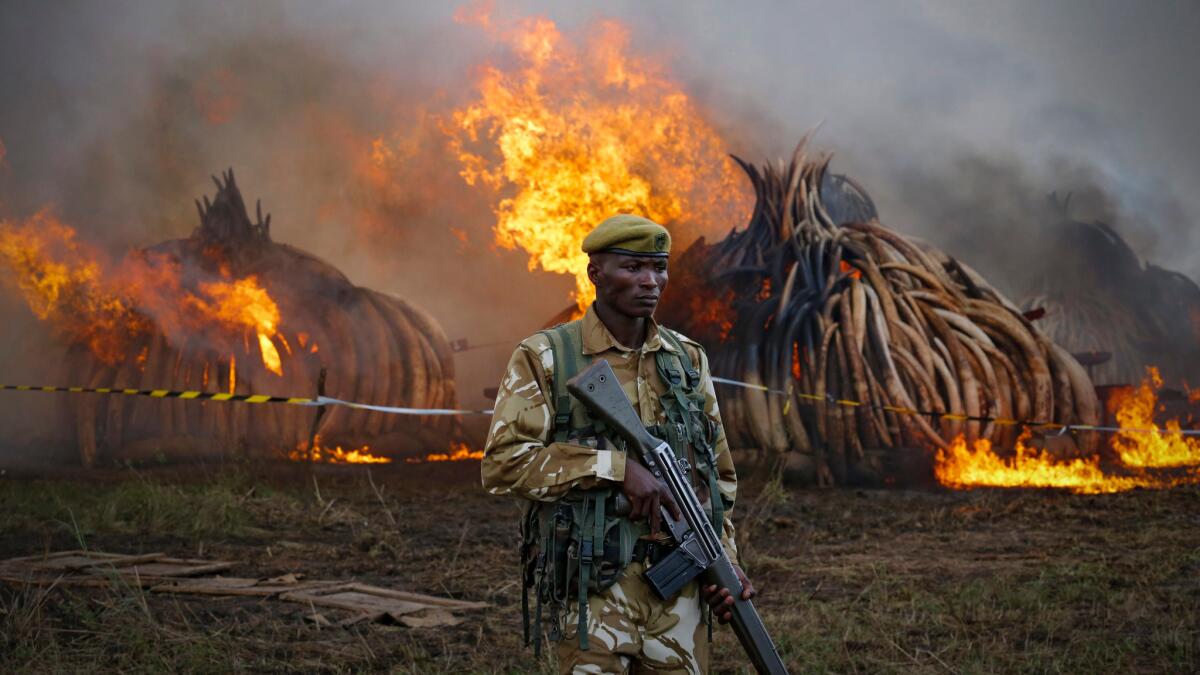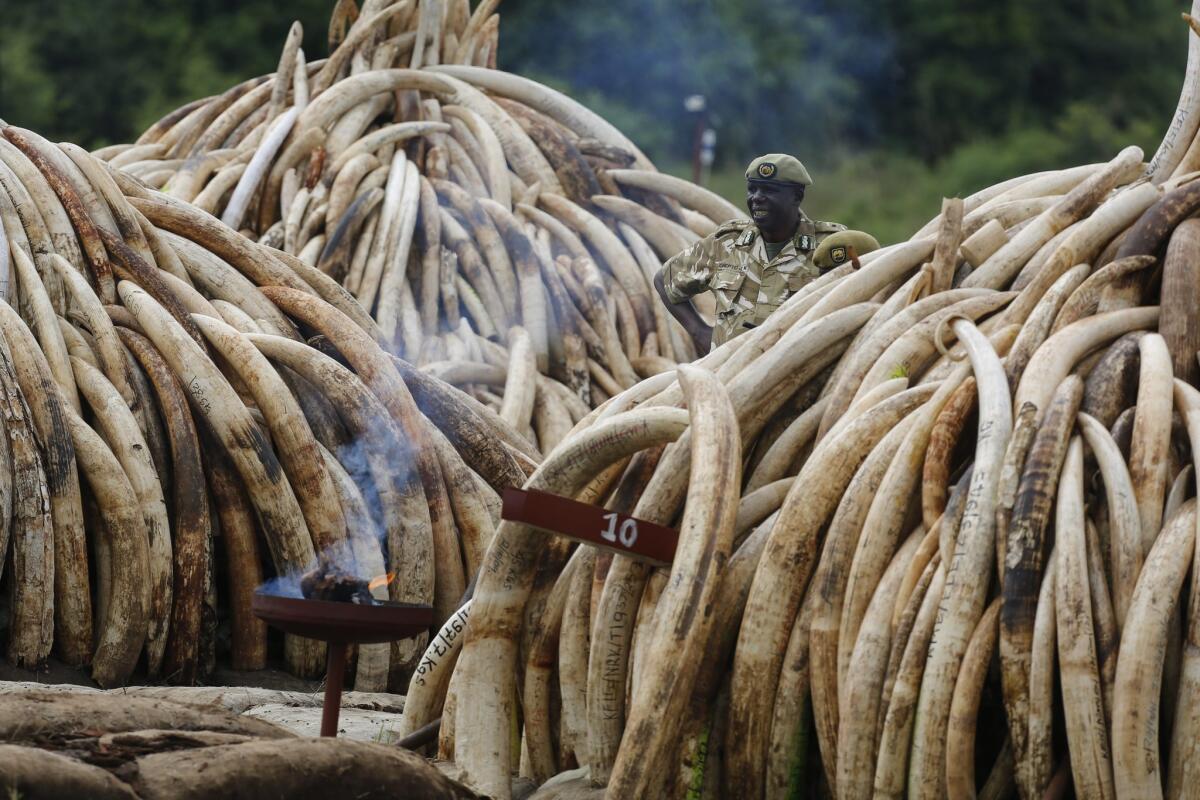More than boots and bullets: This app could help turn the tide on poaching

- Share via
The newest weapon in the fight against wildlife poaching and illegal logging doesn’t rely solely on boots or bullets, but on a computer software application driven by artificial intelligence.
Called Protection Assistant for Wildlife Security, or PAWS, the app uses algorithms – similar to the mathematical models used to power computer games – to devise strategies for defeating those who seek to destroy nature.
Thousands of animals are illegally slaughtered each year for their ivory, skin and bones for use in traditional medicines and feeding black market demand, while others meet their death at the hands of illicit trophy hunters, in what the World Wildlife Fund refers to as “a global poaching crisis.”
Last year alone, around 30,000 elephants and a record 1,338 rhinos were killed in Africa, while tens of thousands of other animals were poached and trafficked, “feeding an illegal wildlife trade that is increasingly being driven by international organized crime,” the international conservation group said in a recent statement.

Developed in 2013 and still in the test phase, the PAWS software analyzes data on terrain, topography, routes most frequently used by animals and paths traveled by poachers, said Milind Tambe, a computer scientist and professor of industrial systems engineering at USC who developed the technology with his doctoral students, including Fei Fang and Thanh Nguyen.
The Army Research Office and the National Science Foundation funded the research.
NEWSLETTER: Get the day’s top headlines from Times Editor Davan Maharaj >>
“We can do pattern recognition, essentially building a model and predicting poachers’ activity based on their past actions,” Tambe said. “We can build up predictions of where poachers may strike. Then that allows us to generate patrol strategies that would be effective against those types of poachers. ”
For example, the system can generate random patrol routes for rangers in order to keep potential poachers guessing about the whereabouts of the wardens.
The technology has been tested in Malaysia and Uganda, where it was successfully loaded onto handheld GPS devices that teams of rangers could use on the ground.

Patrols will be launched in Queen Elizabeth National Park in western Uganda in the coming months. Uganda is home to some of the world’s most threatened ecosystems. Andrew Plumptre, director of the Albertine Rift Program for the Wildlife Conservation Society in Uganda, said he was eager to see the app put to the test.
------------
FOR THE RECORD
10:19 a.m.: An earlier version of this article misspelled Andrew Plumptre’s name as Plumtre.
------------
Plumptre said ranger patrols comprise the greatest portion of the Uganda Wildlife Authority’s budget for all of its parks and wildlife reserves, and recent studies show an average of 42% of households around two of Uganda’s key elephant strongholds admitted to hunting in the parks in the past year.
While many of the hunters do so out of a desperate need for money to pay for essentials such as healthcare or school fees, “there are regular poachers who can earn significant amounts of money from the hunting,” Plumtre said in an email.
“Making the patrolling more efficient and effective could greatly improve funding for other activities that are also needed, such as removal of invasive plants, and programs with the local communities,” he added.

In Malaysia, where Tambe and his researchers teamed with the wild cats conservation group Panthera to test guided patrols using the artificial intelligence technology, the program yielded positive outcomes.
A research paper authored by the USC team, Panthera and other researchers noted that PAWs was able to guide rangers toward poaching hot spots by suggesting feasible and detailed routes. The technology also proved beneficial “at finding good ridgelines that are taken by animals and humans” and easier for the rangers the follow, according to the report.
Having the software do the work could potentially reduce the burden of patrol planning, the researchers found.

But they also found limitations. For example, one of the routes PAWS suggested for rangers on foot patrol in Uganda traversed a body of water, forcing the wardens to walk along the water’s edge and slowing them down. Extreme changes in elevations on routes suggested by the software could stop patrols in their tracks. The technology was unable to provide detailed patrol routes in large conservation areas, and questions remain about maintaining and upgrading the software, Tambe said.
Sean Willmore, president of the International Ranger Federation that includes 71 member associations on six continents, said that while technology is important in the fight to protect wildlife, it is “not the silver bullet.” He said more should be done to support the basic needs of rangers.
“I don’t want to dismiss the technology, but it is pointless if we don’t have rangers who are trained and rangers who can use that technology,” Willmore said. He also stressed rangers’ need for basic field equipment, such as wet weather gear and mosquito nets.
In addition, technology can do little to predict how poachers might react when discovered by rangers, Willmore said, and encounters with poachers can prove lethal. According to ranger federation statistics, an estimated 100 rangers are killed on the job each year. Around 70% of them were murdered by poachers who are eager to protect a business that generates around $19 billion a year in profits, Willmore said. Others succumb to other work-related hazards such as drowning, sickness from tropical diseases and animal encounters.
PAWS researchers said promoting the technology was not intended to overshadow the practical needs of rangers.
“We’re building a decision aide,” Tambe said. “We are saying to the rangers here is a tool that may effectively help you. I believe that artificial intelligence, if properly understood, can be used for the social good.”
ALSO
New fossil find in Indonesia could represent the ancestors of the mysterious “Hobbit” species
What it’s like to live in the world’s fastest growing major economy
Uber tweaks its app in bid to appease drivers
More to Read
Sign up for Essential California
The most important California stories and recommendations in your inbox every morning.
You may occasionally receive promotional content from the Los Angeles Times.











